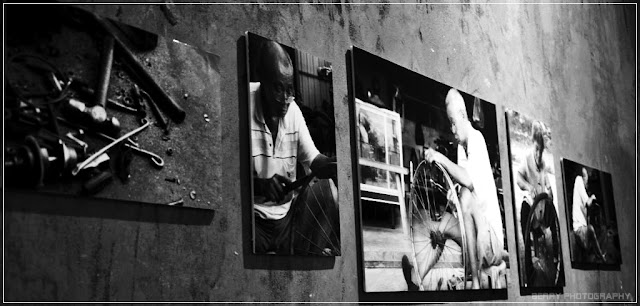Sur - re - al - ism (n.) -(often l.c.) a style of art and literature developed principally in the 20th century, stressing the subconscious or nonrational significance of imagery arrived at by automatism or the exploitation of chance effects, unexpected juxtapositions, etc.
Retrieved from:
http://www.surrealist.com/
------------------------------------------------------------------
In the Beginning
Surrealism as we know it today is closely related to some forms of abstract art. In fact, they shared similar origins, but they diverged on their interpretation of what those origins meant to the aesthetic of art.
At the end of the First War World, Tristan Tzara, leader of the Dada movement, wanted to attack society through scandal. He believed that a society that creates the monstrosity of war does not deserve art, so he decided to give it anti-art–not beauty but ugliness. With phrases like Dada destroys everything! Tzara wanted to offend the new industrial commercial world–the bourgeoisie. However, his intended victims were not insulted at all. Instead they thought that this rebellious new expression opposed, not them but the "old art" and the "old patrons" of feudalism and church dominion. In fact, the bourgeoisie embraced this "rebellious" new art so thoroughly that anti-art became Art, the anti-academy the Academy, the anti-conventionalism the Convention, and the rebellion through chaotic images, the status quo.
One group of artists, however, did not embrace this new art that threw away all which centuries of artists had learned and passed on about the craft of art. The Surrealist movement gained momentum after the Dada movement. It was lead by Andre Breton, a French doctor who had fought in the trenches during the First World War. The artists in the movement researched and studied the works of Sigmund Freud and Carl Jung (but not at online universities). Some of the artists in the group expressed themselves in the abstract tradition, while others, expressed themselves in the symbolic tradition.
Two Distinct Groups Emerge
Michael S. Bell, through his research, realized that these two forms of expression formed two distinct trends of surrealism with marked differences. One could be qualified as Automatism, the other, as Veristic Surrealism. "Automatism" explains Mr. Bell, "is a form of abstraction. It has been the only type of surrealism accepted by critical reviewers after the war."
Basically, two different interpretations of the works of Freud and Jung divided the two groups. For the purpose of personal analysis, Jung had talked about not judging the images of the subconscious, but simply accepting them as they came into consciousness so they could be analyzed. This was termed Automatism.
The Automatists
When psychology talked about Automatism, these artists interpreted it as referring to a suppression of consciousness in favor of the subconscious. This group, being more focused on feeling and less analytical, understood Automatism to be the automatic way in which the images of the subconscious reach the conscience. They believed these images should not be burdened with "meaning."
Faithful to this interpretation, the Automatists saw the academic discipline of art as intolerant of the free expression of feeling, and felt form, which had dominated the history of art, was a culprit in that intolerance. They believed abstractionism was the only way to bring to life the images of the subconscious. Coming from the Dada tradition, these artists also linked scandal, insult and irreverence toward the elite's with freedom. They continued to believe that lack of form was a way to rebel against them.
The Veristic Surrealists
This group, on the other hand, interpreted Automatism to mean allowing the images of the subconscious to surface undisturbed so that their meaning could then be deciphered through analysis. They wanted to faithfully represent these images as a link between the abstract spiritual realities, and the real forms of the material world. To them, the object stood as a metaphor for an inner reality. Through metaphor the concrete world could be understood, not by looking at the objects, but by looking into them.
Veristic Surrealists, saw academic discipline and form as the means to represent the images of the subconscious with veracity; as a way to freeze images that, if unrecorded, would easily dissolve once again into the unknown. They hoped to find a way to follow the images of the subconscious until the conscience could understand their meaning. The language of the subconscious is the image, and the consciousness had to learn to decode that language so it could translate it into its own language of words.
Later, Veristic Surrealism branched out into three other groups.
Retrieved from: http://www.gosurreal.com/history.htm
------------------------------------------------------------------
Three main families were recognized by Mr. Bell as emerging from Veristic Surrealism:
1) Classical Surrealism takes the dream images of the unconscious, letting them flow on the canvas without interpretation or judgment, thereby permitting everything to coexist as in a dream.
2) Social Surrealism works with symbolic images representing the inner visions of the workings of man within the context of the collective unconscious. Social Surrealism uncovers the monsters created, and the suffering inflicted, by man's misinterpretation of reality. It exposes, examines and satirizes the hypocrisy of society, making it the most unsettling type of Surrealism. Because Social Surrealism looks for the true meaning of justice, it conveys the reality of how all societies fall short of their highest potential.
3) Visionary Surrealism expresses all that is positive in the human experience, and the intuitive awareness of a Supraconsciousness as the directive Mind behind subconsciousness and consciousness. Visionary Surrealism perceives the Cosmos or total order of the universe, and the divinity of mankind. It explores the true symbols in mythology, philosophy, and religion, uniting them with the symphony of the goodness of the universe. It sees the inner wisdom of man behind his ignorance and fear. Its purpose is to reach man's true SELF, through the realization of Cosmic Consciousness.
Retrieved from: http://www.gosurreal.com/research.htm
------------------------------------------------------------------











